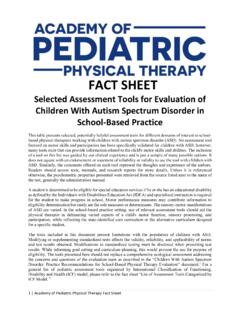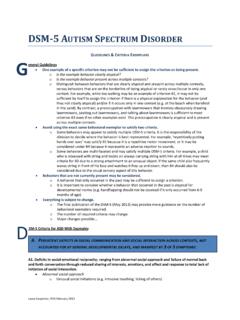Transcription of Promoting emotional wellbeing and positivemental health …
1 health Visiting and School Nurse Programme: Supporting implementation of the new service offer: Promoting emotional wellbeing and positive mental health of children and young peopleRationale and ContextExamples of emotional health and wellbeing supportConfident to be CuriousWhat works locally: case studies, Acknowledgement and referencesRationale and ContextMental health , wellbeing and resilience are crucial to a host of social care and economic benefits as well as supporting physical health , positive relationships, education and work. Unlocking the benefits of better health and wellbeing for all requires a sustained, systematic and concentrated effort (Confident Communities, Brighter Futures, HM Government, 2010). There is very strong evidence that investment in Promoting the mental health and wellbeing of parents and children notably in the pre-school years, can avoid health and social problems later in life.
2 Given the significance of parenting and family influences on child health outcomes, health visitors and school nurses are well placed to play a key role in Promoting emotional wellbeing and positive mental health of children, young people and their families. They have a specific contribution to make in identifying issues, using protective screening and providing effective document outlines the contribution that the health visiting and school nursing service can make to improving emotional health and wellbeing outcomes for children, young people and their families. It describes different levels of intervention across the 4 tiers of the new health visiting and school nursing service document builds on No health Without Mental health (2011) and recognises the vital role of partner agencies and the need for local collaboration in commissioning and delivery. It provides more specific focus and clarity for health visitors and school nurses to support their roles.
3 The aim is to implement new evidence to ensure healthy start includes building the emotional resilience which is vital in life chances. This guidance shows how health visiting and school nursing services can provide input in terms of prevention, early intervention, on-going support and referral to specialist services, whilst working collaboratively with partnership organisations. health Visitors and School Nurses are well placed to identify issues, use protective screening and provide effective support. Using this approach not only supports good mental health , but is economically more effective Mental health promotion and mental illness prevention: The economic case, London School of Economics and Department of health , 2011 Using key data on child and adolescent mental healthChild and adolescent mental health disorders are common. They affect 10-20% of children and young people with the most recent UK figure indicating that 10% of 15-16 year olds have a diagnosed mental health disorder.
4 Common mental health disorders and difficulties encountered during childhood and the teenage years include: ADHD (Attention Deficit Hyperactivity Disorder); anxiety and a range of anxiety disorders ranging from simple phobias to social anxiety, generalised anxiety and PTSD (Post Traumatic Stress Disorder); autism and Asperger syndrome (the autism spectrum disorders, or ASD); behavioural problems; depression; eating disorders (including anorexia nervosa and bulimia); self harm; obsessive compulsive disorder (OCD); psychotic disorders- and in particular schizophrenia; and substance in 6 adults in the UK are reported to have a mental health problem. It is thought that approximately half of all lifetime mental disorders start by the mid-teens (Barnardos, 2009).Data and evidence should be used by health visitors and school nurses need to; Assess the health and wellbeing needs of children and young people and provide early identification of risk factors advice & support for children & young people with long-term conditions; support for travellers health needs; repeat A&E admissions.
5 Assess parenting to identify areas of actual or potential parenting issues, and early identification of risk factors knowledge and attitude to child rearing; quality of mother child interaction; parental perception of child behaviour; client s experience of adverse family interactions Understand what works for population at risk parents that may have significant difficulties; history of being in care, mental health difficulties, learning difficulties, current alcohol/drug misuse, poverty, homelessness, teenage parents/carers. Use existing models and evidence already in place and analyse/evaluate to develop best practice dissemination Signposting to parenting support, group parenting and family support programmes, including support with home learning environment and peer led support Work within the early years and schools settings to support a holistic approach to emotional health and wellbeing peer mediation, bullying prevention, pupil involvement in supported learning Promote mentally healthy environments including access to green space and good quality homes signposting to advice Evidence based practice: Five ways to wellbeingPoor mental health is both a contribution to and a consequence of wider health inequalities.
6 health Visitors and School Nurses, with partner agencies have a crucial role in positive mental health within a family context and in creating confident communities and brighter futures for all. To ensure emotional health and wellbeing is promoted and ensuring that seamless services are provided, the following need to be addressed: Raising the profile of health visitors and school nurses contribution to emotional wellbeing and mental health Developing guidance / tools for transition with clear role definition for health visitors and school nurses to ensure clear transition pathways Actively engaging Promoting transition points across the life course for children and young people providing a joint and holistic approach to support the child and family Ensuring shared training opportunities and regular updating of resources Ensuring effective support during transition pathsFive ways to WellbeingThe Children s Society and New Economics Foundation have explored the relevance of the Five Ways to wellbeing to the lives of children and young ways to wellbeing .
7 New applications, new ways of thinking, National Mental health Development Unit and New Economics Foundation, 2011 The Children s Society and New Economics Foundation adapted the Five Ways to wellbeing to become more appropriate for use with children and young Economics Foundation: Five Ways to a Happy ChildhoodThe five steps provide the framework for health Visitors and School Nurses working with children, young people and families, as well as an organisational tool to effect cultural Enable young people to spend time with friends and Urge young people to exercise regularly, either on their own or in a Encourage awareness of environment and Keep young people s world as large as possible, encouraging their natural and Encourage children s imagination and creativity as they focus on building resilience and confidenceMarmot (2010) reinforces the need for a life course approach to tackling inequalities, to build resilience and wellbeing of children and young people across the social gradient.
8 Support needs to be in place before birth and subsequent stages throughout the life of the child to ensure positive outcomes. Healthy Lives, Healthy People (2010), outlined the need to build self esteem, confidence and resilience. This can be achieved by: Recognising that the importance of good relationships with family, friends and others is paramount in building resilience Recognising the importance of parental wellbeing can affect the child s emotional health and wellbeing and resilience Ensuring early identification of need and provision of evidence based family centred support Focusing on early intervention and early help both in early years and at trigger points during school-aged years Focusing on early identification of those women at risk of postnatal depression through antenatal assessment and post-natal depression screening, recognising family dynamics to provide a whole family approach Encouraging partnership working to deliver a comprehensive service offer Ensuring seamless support across the transitions from midwifery, health visiting.
9 And school nursing services Recognising the value of multi-agency delivery with clear co-ordination Enhancing parenting strategies the incredible years Identifying and consideration of strengths versus risk when working with families. Ensuring developmental assessments to indicate .developmental concerns and delays Developing evidence based pathways and protocols with outcome measuresCollaborative support: a summary of key messagesSupporting emotional health , wellbeing and resilience requires a collaborative approach across a number of agencies. Collaboration will enhance delivery but can only be achieved by effective team and multi-agency working, which requires: Providing leadership to shape teams and provide direction for delivery Ensuring effective referral systems are in place Encouraging multi-disciplinary team discussions Encouraging reflective review to make service improvements and supporting insightful challenge Using peer review to support critical appraisal to enhance practice Supporting inter professional learning and development Providing protected time for supporting and developing professional networking and support groups Connect Be active Take notice Keep learning Creativity and playEffective commissioning for effective service delivery The core aims of effective commissioning are to.
10 Improve mental health and wellbeing of the population Improve the quality and accessibility of services Ensuring commissioning is underpinned by robust data and evidence including service user feedback Ensuring services are developed and delivered based on local need, use evidence based intervention and are reviewed to ensure impact and positive outcomes Utilising robust processes for collection of service user feedback to enhance and shape services Ensuring data and feedback is provided to influence effective commissioning Supporting parenting and family life Supporting school readiness Developing whole school approaches to health and wellbeing Promoting mentally healthy environmentsSuccess can be measured through:1. Improved mental health literacy in children and young Improved resilience for children, young people and families3. Improved children, young people and families emotional wellbeing and mental health 4.











